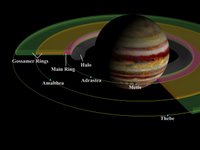 | Target Name: J Rings, Is a satellite of: Jupiter, Mission: Galileo, Spacecraft: Galileo Orbiter, Instrument: Solid-State Imaging, Product Size: 2560 samples x 1920 lines, |
Original Caption Released with Image: This schematic cut-away view of the components of Jupiter's ring system shows the geometry of the rings in relation to Jupiter and to the small inner satellites, which are the source of the dust which forms the rings.
The Formation of Jupiter's Ring System, The innermost and thickest ring, shown in gray shading, is the halo that ends at the main ring. The thin, narrow main ring, shown with red shading, is bounded by the 16- kilometer-wide (10-miles) satellite Adrastea and shows a marked decrease in brightness near the orbit of Jupiter's innermost moon, Metis. It is composed of fine particles knocked off Adrastea and Metis.
Although the orbits of Adrastea and Metis are about 1,000 kilometers (about 600 miles) apart, that separation is not depicted in this drawing. Impacts by small meteoroids (fragments of asteroids and comets) into these small, low-gravity satellites feed material into the rings. Thebe and Amalthea, the next two satellites in increasing distance from Jupiter, supply dust which forms the thicker, disk-like "gossamer" rings. The gossamer rings, depicted with yellow and green shading, are thicker because the source satellites orbit Jupiter on inclined paths
Satellite Interactions with Jupiter's Ring System, These small satellites all orbit closer to Jupiter than the four largest Galilean satellites, Io, Europa, Ganymede and Callisto, which were discovered nearly 400 years ago. The orbital distances of the moons are drawn relative to the size of Jupiter.
The Jupiter image was created from a map based on data obtained by the Hubble Space Telescope. JPL manages the Galileo mission for NASA's Office of Space Science, Washington, DC. The images are posted on the Internet at photojournal.jpl.nasa.gov/ and at galileo.jpl.nasa.gov/. Background information and educational context for the images can be found at: jpl.nasa.gov/galileo/sepo .
NASA images generally are not copyrighted. Unless otherwise noted, images and video on JPL public web sites (public sites ending with a jpl.nasa.gov address) may be used for any purpose without prior permission. The endorsement of any product or service by Caltech, JPL or NASA must not be claimed or implied.
Leave a comment, make a request, Let this small sampling be a guide to better quality, more plentiful, public domain, royalty free, copyright free, high resolution, images, stock photos, jpeg, jpg, free for commercial use, clip art, clipart, clip-art. more at Public Domain Clip Art and clip art or public domain and Space or NASA and Hubble Space Telescope or Jupiter and Galilean satellites













No comments:
Post a Comment